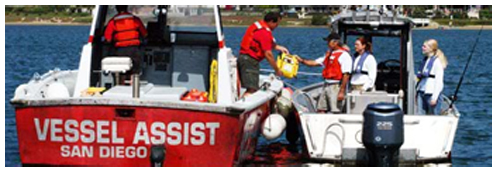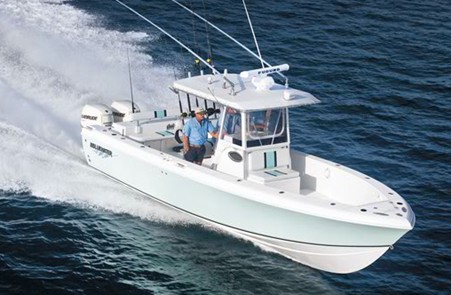How far will your boat travel on a tank of fuel?
Walking around boat shows these days I see plenty of boat dealers boasting about the 400 and 500 mile range (per fuel tank) of the boats that they’re selling. I’m sure that with new technology and modern hull designs they are pretty close but how can you be sure of what your fishing or cruising range really is?
The most common phrase I hear when a boater runs out of fuel is, “My Gas gauge still say’s I have ¼ tank!” During the last 10 years Vessel Assist San Diego has delivered fuel to over 5000 boaters; about 80 percent of them report that their fuel gauge shows that they still have fuel, about ten percent think that there is a problem with their fuel system, five percent have no idea that they are out of gas and believe they are suffering a mechanical issue, and finally, about the last five percent are just flat out honest and say, ”oops, looks like I went a little too far with my boat today.”

Well here is a simple way to find out what the actual range of your boat is* (as well as an opportunity to “sea trial” your boat so that you can address any issues your boat might have so you can lessen the chance of a major breakdown during the middle of your boating or fishing season):
Before you launch your boat make sure that your hull is clean and free of growth. For trailer boaters this is an easy task, for those of you who keep your boat in a slip you may have to hire a service if you’re unable to dive yourself. Most of the companies that offer bottom cleaning will also inspect the condition of the zincs, shaft(s), prop(s), and rudder(s). While bottom growth seems slippery it isn’t, growth equals drag or resistance and it negatively affects your fuel economy. My boats burned more than 40,000 gallons of fuel in 2008 and we can tell when the bottoms need to be cleaned just by looking at our gph (gallons per hour) burned.
You should also make sure that your propeller(s) are true (no bends) and free of dings. A propeller going through the water is like cutting a tomato with a knife; if the blade is sharp and true it will slice through the water like a sharp knife through a tomato on the other hand, if the knife is dinged or has been bent a little it will still cut through the tomato but not as smooth. If the propeller looks dinged it to Pacific Marine Propellers in National City (or any other propeller repair shop) and for a fraction of the cost of a new prop they can repair and tune your propeller.
Now that you know your hull is clean and your props are in working order on to the test.
Before you depart make sure that your Membership card coverage is current and that you have a working hour meter on board (if you don’t, they can be installed quickly and affordably).

For this example we will assume the following scenario:
We are operating out of San Diego Bay in a 24’ boat with 100 gallons of fuel on board and at an average cruising speed of 22kts.
STEP 1:
We head to our local fuel dock and fill the boat as we normally would before a boating or fishing trip. At this point log we log our engine hours. Some of the newer electronics packages, like the ones by Garmin and Raymarine, have trip meters, if yours does zero the mile meter. Using a stop-watch to measure our time, we take off out of San Diego Bay at our typical cruising speed (22kts) and head to South Coronado Island, then back to Pt. Loma, into San Diego Bay down to the bridge, and then back to the fuel dock.
Step 2:
When we’re back at the fuel dock we stop our stop-watch, refuel the boat, and log both our engine hours and start/stop times from the stop-watch. Now we have the data that we will need to determine our burn rate.
Step 3:
On our trip we burned 35 gallons of fuel at an average speed of 22 knots and it took just over 2 hours to run 45 nautical miles. Now lets do the math, 35 gallons at 2 hours is 17.5 gallons per hour (round up 18.0 gallons per hour). With a 100 gallon capacity we subtract 5% off the top, so we assume that we have 95 gallons of usable fuel, then we subtract 10% for reserve and we end up with 85 gallons of fishing or cruising fuel. Next we use the 40/20/40 method to figure out our fishing or cruising range. We use 40% of the fuel to get to the fishing grounds, 20% to fish at trolling speed and 40% to get home. So we can cruise a total of 22 knots for about 4.5 hours or about 100 miles. We can troll and fish (most people troll at 6 to 8 knots) for 2 hours before we need to cruise back home (at 22 knots). This leaves us with a 10 gallon reserve or an additional 1/2 hour of running is. So we take the range and deduct 10% or 10 miles and the fishing range for this boat is about 80 miles with 2-3 hours of trolling time.
Now not too many people take their 24’ boat out 80 miles but lets say you that wanted to go to the 371 (or about 40 miles offshore). With this boat you could cruise out, fish a few hours and then run back home with fuel to spare.
The point here is that it’s important to measure your gallons per hour, and NOT rely solely on the fuel gauge. In fact, on my boats, the hour meters fit perfectly where the fuel gauges used to be.
______________________
* Author’s Note: This is the method I use to figure out the range of my boats but ultimately it is up to you, the boat operator, to accurately find the range of your own vessel.
I am neither guaranteeing nor suggesting that you can take your boat to its full estimated fishing range. The weather, seas, and condition of your boat, as well as you, the operator, will affect the ACTUAL your range of your vessel. Boat safely and at your own risk.

